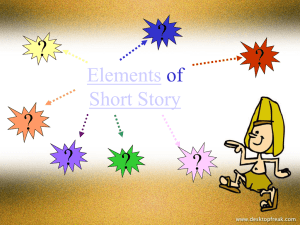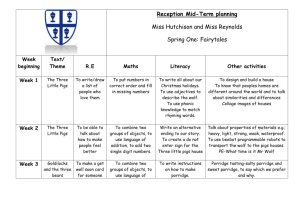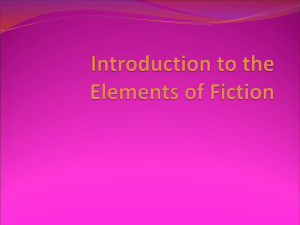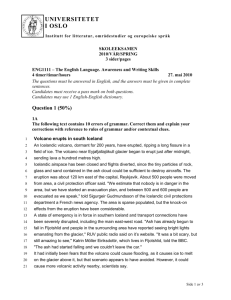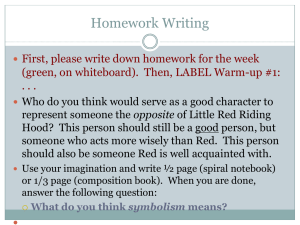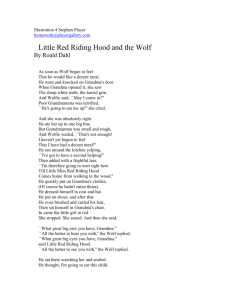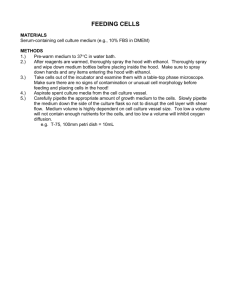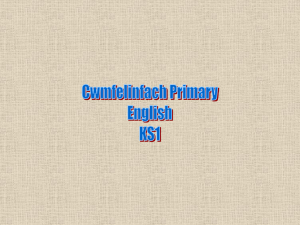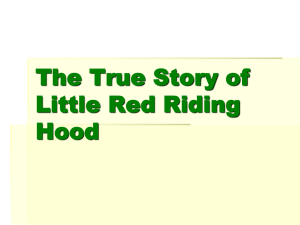Red Riding Hood/Jane Tesh/Created by Cleveland District Unit 4
advertisement
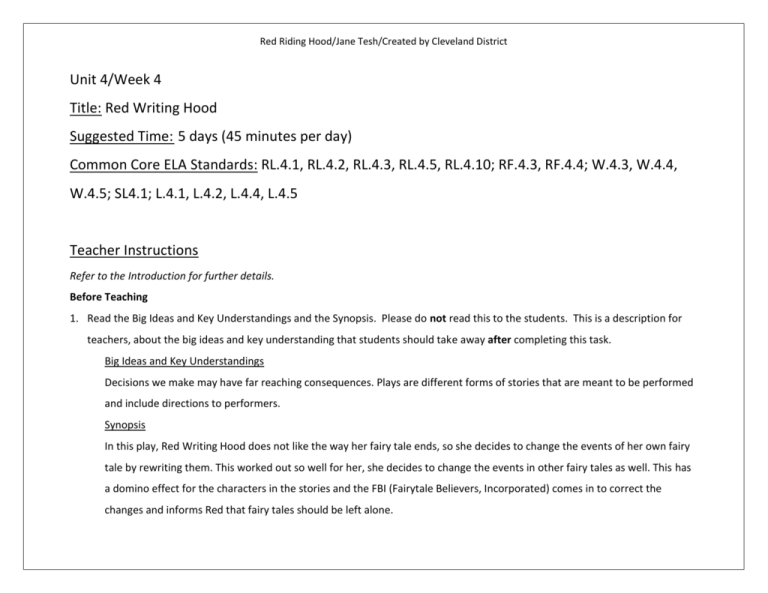
Red Riding Hood/Jane Tesh/Created by Cleveland District Unit 4/Week 4 Title: Red Writing Hood Suggested Time: 5 days (45 minutes per day) Common Core ELA Standards: RL.4.1, RL.4.2, RL.4.3, RL.4.5, RL.4.10; RF.4.3, RF.4.4; W.4.3, W.4.4, W.4.5; SL4.1; L.4.1, L.4.2, L.4.4, L.4.5 Teacher Instructions Refer to the Introduction for further details. Before Teaching 1. Read the Big Ideas and Key Understandings and the Synopsis. Please do not read this to the students. This is a description for teachers, about the big ideas and key understanding that students should take away after completing this task. Big Ideas and Key Understandings Decisions we make may have far reaching consequences. Plays are different forms of stories that are meant to be performed and include directions to performers. Synopsis In this play, Red Writing Hood does not like the way her fairy tale ends, so she decides to change the events of her own fairy tale by rewriting them. This worked out so well for her, she decides to change the events in other fairy tales as well. This has a domino effect for the characters in the stories and the FBI (Fairytale Believers, Incorporated) comes in to correct the changes and informs Red that fairy tales should be left alone. Red Riding Hood/Jane Tesh/Created by Cleveland District 2. Read entire main selection text, keeping in mind the Big Ideas and Key Understandings. 3. Re-read the main selection text while noting the stopping points for the Text Dependent Questions and teaching Vocabulary. During Teaching 1. Students read the entire main selection text independently. 2. Teacher reads the main selection text aloud with students following along. (Depending on how complex the text is and the amount of support needed by students, the teacher may choose to reverse the order of steps 1 and 2.) 3. Students and teacher re-read the text while stopping to respond to and discuss the questions and returning to the text. A variety of methods can be used to structure the reading and discussion (i.e.: whole class discussion, think-pair-share, independent written response, group work, etc.) Text Dependent Questions Text Dependent Questions Orally summarize and identify the main problem, or conflict, in familiar fairy tales and nursery rhymes such as Miss Muffet, Goldilocks, or Red Riding Hood. A play is a story that can be performed for an audience. What identifies this selection as a play? Words in parentheses show directions for characters’ actions. Draw conclusions about why these directions are important. How do they affect the play? What is the purpose of the “aside” direction? Answers Example of answers: Miss Muffet is frightened by a spider, Goldilocks eats the three bears’ porridge, Red Riding Hood encounters a wolf. Characters’ actions and feelings shown through dialogue and stage directions. The directions are important because they make the play more interesting by adding details as when the wolf pirouettes off and when Red shouts triumphantly. When the wolf or Red speaks to the audience in an “aside” the other characters Red Riding Hood/Jane Tesh/Created by Cleveland District What is a cast of characters? Baby Bear uses the idiom, “She’s eating us out of house and home!” What is the meaning of this figurative language? What causes Red to rewrite the script for Red Riding Hood? What happens to the sequence of events when Red changes Miss Muffet’s story? What is the meaning of the word offstage and how did you determine the meaning? What happens as a result of Red’s changing Goldilocks into a bear? Red says, “Not anymore,” triumphantly. Triumphantly means in a joyful, successful way. What other word could the author have used (synonym) for triumphantly? Why did the author use the title Red Writing Hood instead of Little Red Riding Hood? Categorize cast members as either major or minor characters and tell why. supposedly don’t know what they are saying. A cast of characters is a list of the characters in a play. She’s eating a lot of food. She knows that the wolf will eat her grandmother and then herself. Miss Muffet is not scared away by a spider, but rather goes away with Prince Charming. Then Cinderella doesn’t have a prince. It means something that cannot be seen by the audience; to the side of the stage. This was determined by looking at the meanings of the parts of the compound word off and stage. The bears adopt Goldilocks as their cub. Possible answers may include: victoriously, proudly, exultantly, gleefully Instead of naming the play “Little Red Riding Hood,” the author calls it “Red Writing Hood” because the main character is writing changes in the scripts. Major: Red Writing Hood, Wolf Minor: Little Miss Muffet, Goldilocks, the Bears, Bo Peep, Cinderella, Princes, Goldilocks’ parents and the agents. Depends on quantity of dialogue and importance to story line. Ad lib means to make up something to say that is not in the script. What are other words that could be an ad lib instead of wait and stop? Example: hold on, halt, slow down, be quiet, or any synonym word or phrase. Agent Anderson reminds Red Riding Hood of how her original fairy tale ends. Why does learning this make a difference for She had forgotten that the woodsman comes and saves her and her granny. The wolf is the one that dies. She doesn’t have to Red Riding Hood/Jane Tesh/Created by Cleveland District her? Why does the wolf want one final chance to change the story? worry about either of them being eaten. The wolf wants to make sure that EVERYONE lives happily ever after, even himself. Red Riding Hood/Jane Tesh/Created by Cleveland District Vocabulary: STUDENTS FIGURE OUT THE MEANING sufficient context clues are provided in the text TEACHER PROVIDES DEFINITION not enough contextual clues provided in the text KEY WORDS ESSENTIAL TO UNDERSTANDING Words addressed with a question or task conflict dialogue aside script offstage ad lib WORDS WORTH KNOWING General teaching suggestions are provided in the Introduction at rise halts pirouettes tuffet curds and whey triumphantly sobbing frantic incorporated injustice circumstances curtain desperately tutu repentant discards Red Riding Hood/Jane Tesh/Created by Cleveland District Culminating Task First, explain why the author used the title Red Writing Hood instead of Red Riding Hood. Then, using details from the text, describe how Red Riding Hood’s changes showed that our choices can have long lasting effects. Additional Tasks Stage, rehearse, and perform the play as written. Performance can be a traditional play, readers’ theater, or even a puppet show. Students create posters for the school advertising the performance, then write (and invite others to write) reviews of the play. After reading reviews and doing self-critique, do a final performance that is video-taped and edited. With a partner, or small group, write a script for a fairy tale or nursery rhyme that has a problem. Change the problem and outcome by rewriting the script. Peers should edit and revise as needed. Play should include all of the details that would have been included in the original tale, so story length should correspond. Answer: Written script containing a change in problem and outcome for a nursery rhyme or fairy tale. Knowledge of main characters, storyline and conflict should be evident in the student writing. The changed script should solve the original problem, possibly creating yet another problem. Piece should show evidence of editing and revising. Oral storytelling: Students think of a personal experience. It should be an event in which they learned a lesson. (Give a personal example from teacher’s life.) Discuss the importance of including descriptive details and speaking clearly at an understandable pace. Students quickly write down the sequence of events. Next, they practice storytelling the event with a partner. After each student has shared, volunteers share their experience with the class.
